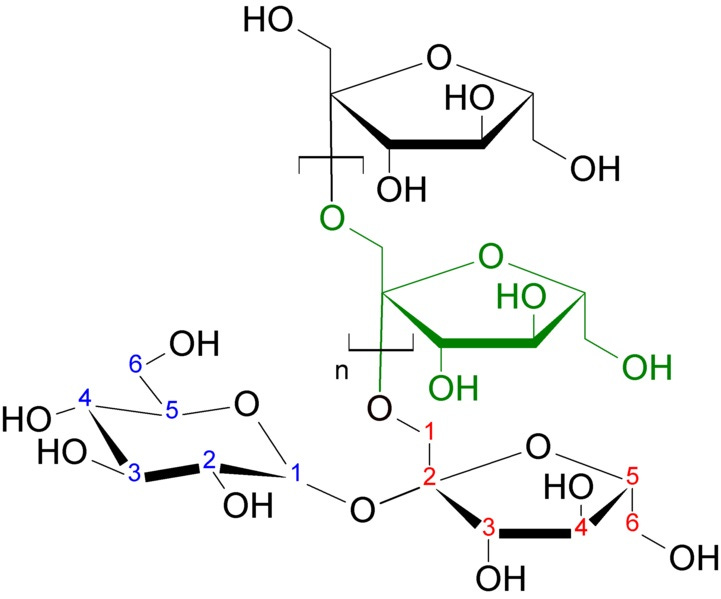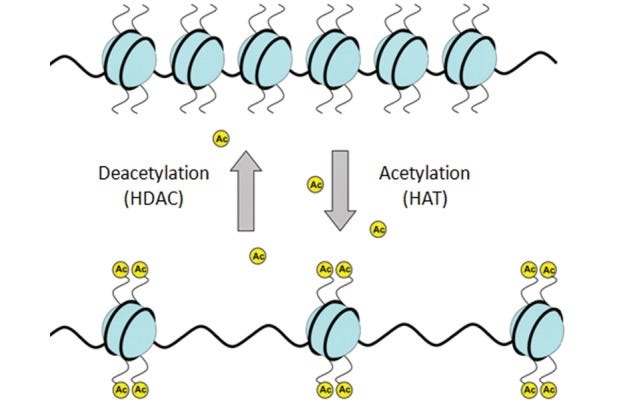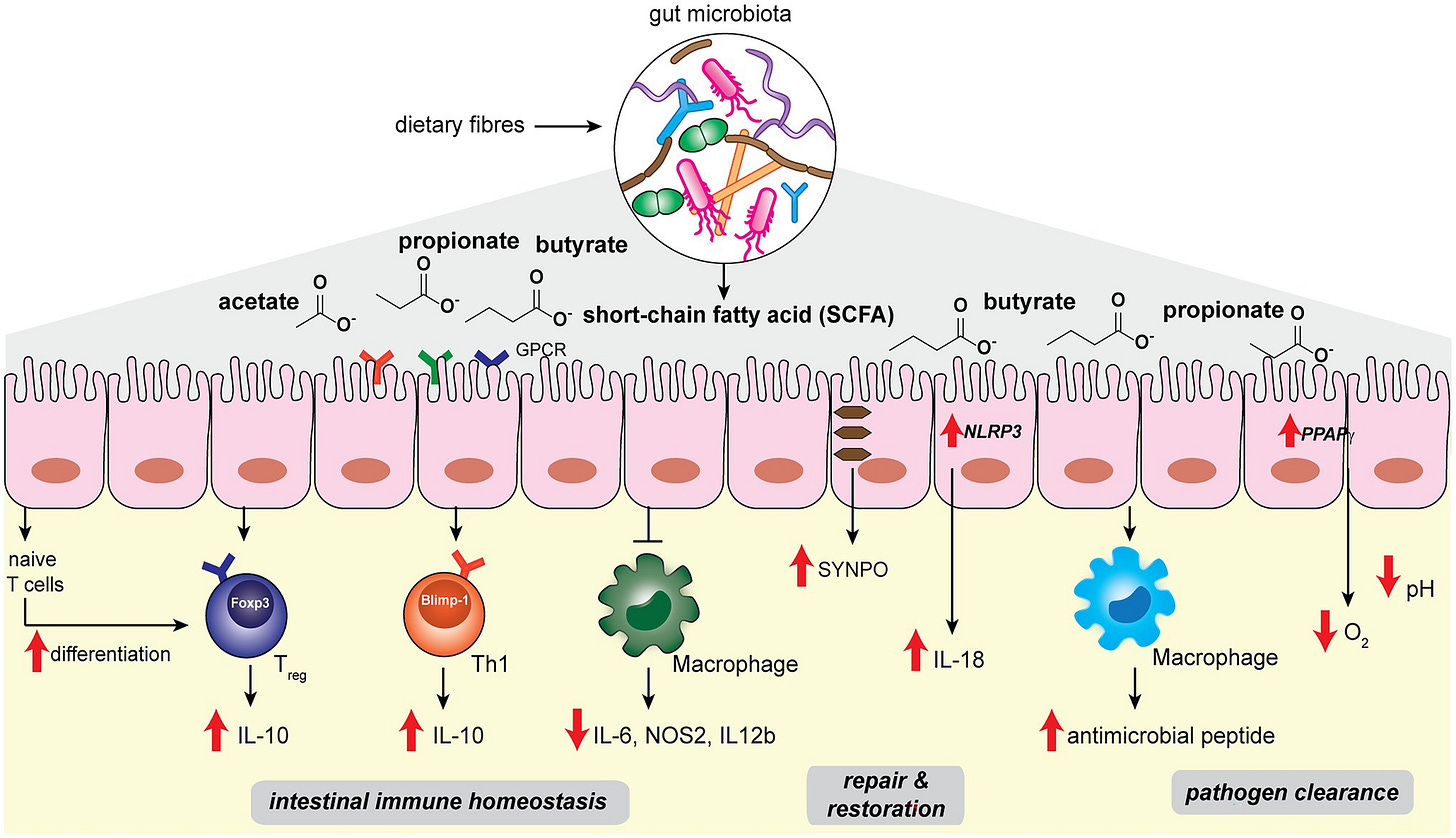Butyric Acid and Its Influence On Digestion, Metabolism, Mitochondrial Activity, and Immune Function (Part 1)
This short-chain fatty acid has a wide range of positive influences on overall health
Butyric acid is an important compound within the digestive system of mammals. Produced by specific intestinal bacteria, particularly those of the Clostridium species, it’s involved in variety of biochemical reactions and physisology functions which include energy metabolism, mitochondrial activity, immune function, and inflammation control. This two-part substack article I will highlight some of butyric acids role in overall health.
Chemical Structure & Food Sources
Image 1 - the chemical structure of butyric acid is a straight-chain akyl carboxylic acid. It’s chemical formula is CH3CH2CH2COOH.
Butyric acid, also called butanoic acid, is a four carbon straight-chain compound containing one carboxylic acid (-COOH) group which contains a carbon double-bonded to an oxygen and single bond to a hydroxyl group (-OH). In liquid form it is has an oily consistency with an unpleasant odor.
It’s found naturally in human breast milk (and bovine milk), animal fat, certain plant oils, and as a short-chain fatty acid (SCFA) produced by anaerobic fermentation within the digestive system. Commonly consumed foods high in butyric acid include butter, ghee, raw milk, parmasen cheese, and certain plant foods including under-ripe bananas, dandelion greens, and Jerusalem artichokes.
The fermentation of resistant starch (resists digestion and ferments), oat bran, and pectin (a high molecular weight water-soluble colloidal carbohyrate found in foods such as apples, grapefruit, and plums) are naturally transformed into butyric acid and other short-chain fatty acids such as acetic acid and propionic acid. Fructans are another source of produced butyric acid through microbiome transformation.
Image 2 - a typical chemical structure of a fructan which is multiple fructose sugars linked in repeating units.
Fructans, a polymer of fructose molecules, are a common source of soluble fiber available for the production of butyric acid. Some examples of fructans, include the following:
artichokes.
asparagus.
beetroot.
chicory.
cruciferous vegetables, i.e., broccoli, onions, and cabbage.
fennel.
garlic.
leeks.
Image 3 - a potpourri of vegetables of fructan rich soluble fibers are an important source of butyric acid through microbiome fermentation.
Examples of Butyric Acid (BA) and Biochemical Reactivity and Physiological Function
Free fatty acid receptors (FFARs)
BA improves metabolic support through increased insulin sensitivity, lipid control, and body composition which includes weight loss. One way BA postively influences these reactions is through facilitation of free fatty acid (FFA) receptors.
Butryic acid acts on free fatty acid (FFA) receptors to facilitate energy balance and homeostatic control. The FFA receptors are nutrient sensors which, in part, regulate hunger signals mediated from the brain, including the hypothalamus, and other organ systems and cells.
Image 4 - long-chain, medium-chain, and short-chain fatty acids (LCFA, MCFA, SCFA, respectively) modulate cellular activity within various cells and organ systems through activation of cellular receptors such as FFAR - https://www.frontiersin.org/journals/physiology/articles/10.3389/fphys.2022.862458/full.
Histone deacetylase regulation
Butyric acid acts as a histone deacetylase (HDAC) inhibitor.
Histones are specialized proteins that act as a spool for DNA to wrap around creating structural units. These units are called nucleosomes. Histones prevent tangling of DNA and are regulated by HDAC. The inhibition of HDAC helps in regulating gene expression within DNA.
Image 5 - Histone deacetylase (HDAC) removes acetyl (AC) groups from a lysine amino acid. Histones are either acetylated (addition of an AC) or deacetylaed (removal of AC) in the overall regulation of DNA expression and transciption availability.
Mucosal Barrier Function
Within the digestive system, butyric acid is important for assisting with mucosal lining integrity and function. Various tight junction proteins, including claudin 7 (not claudin 2 which is involved in increased intestinal permeability) and occludin, are positively influenced by BA. The tight junction protein Zonula Occludens (ZO-1) is upregulated by BA as well helping prevent against leaky gut (see image below).
Immune Modulation
BA is reported to stimulate anti-microbial peptide production within the digestive system. It likely does this through induction of monocyte to macrophage differentiation with an increase in resistance to enteric pathogens.
Other immunological influences of butyric acid is the differentiation of regulatory T cells for improved immune tolerance and prevention against autoimmunity. This regulation aides in preventing excess pro-inflammatory cytokine production.
BA helps with transforming type 1 macrophages (M1) into type 2 macrophages (M2). M1 macrophages are pro-inflammatory and M2 macrophages reduce inflammation and aide in healing. Both are needed for a balanced immune response, particularly during infection, but they need to be tightly regulated.
Image 6 - the gut microbiotia produce various short-chain fatty acids, including butyric acid, which aide in digestive function and have influences on immune function and inflammation.
In the above image notice the following with regards to butyric acid:
Influences macrophages to produce antimicrobial peptides.
Helps naive T cells to differentiate into regulatory T cells (Tregs). This influences the production of interleukin-10 (IL-10) which is important for inflammation control.
Blocks excess production of pro-inflammatory cytokines, such as interleukin-6 (IL-6), from macrophages.
Positively influences NLRP3 inflammasome leading to decreased inflammation. This occurs through NF-kB regulation and downstream transciption factor reactions within various cells, including macrophages. To learn more about NLPR3 inflammasome and NF-kB the my previous Substack article series on NLRP3.
Cellular Metabolism & Mitochondria
Image 7 - NaB is sodium butyrate, the salt of butyric acid - https://onlinelibrary.wiley.com/doi/10.1155/2020/1904609
There are so many cellular influences from butyric acid it’s challenging to go through them all. With regards to image 7, here are few highlights:
Improves insulin receptor sensitivity causing a decrease of insulin resistance. This allows for decreased oxidative stress which positively helps many cellular structures and organelles, e.g., mitochondria).
Positive influence over oxidative stress with increase glutathione peroxidase and superoxide dismutase activity.
Regulation of HDAC which influences gene transcription.
Increased beta-oxidation (β-oxidation) for improved adenosine triphosphate (ATP) production.
With improved insulin sensitivity, decreased oxidative stress, and increased mitochondrial activity for energy production (and other influences), there is an overall improved status of the cell which translates into better organ function and overall health.
Conclusion
Butyric acid is an important compound in overall health. Its influence throughout different cellular systems is extensive with a major one being energy metabolism. In article 2 of this two-part series, I will explain more about butyric acids influence on mitochondrial function, and the relationship this has to controlling inflammation.











